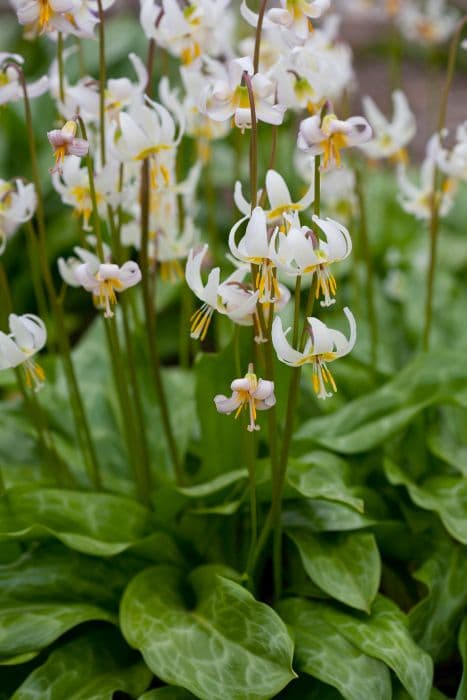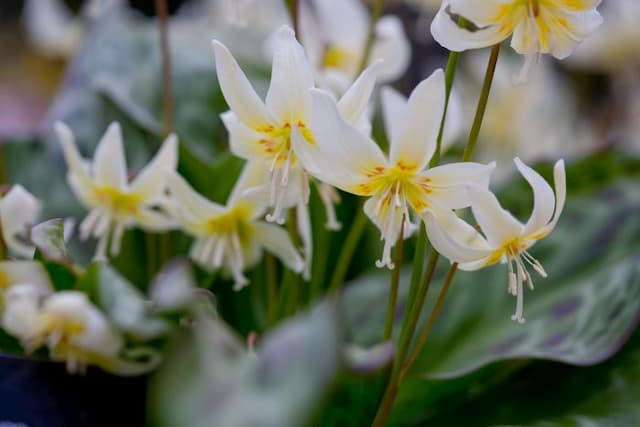Tulip Tulipa 'Strong Gold' (3)

ABOUT
Tulipa 'Strong Gold', often known simply as tulips, features a striking appearance with bold blooms that demand attention. These tulips are characterized by their vibrant golden-yellow petals, which stand out against the green foliage. Each petal has a smooth texture and comes to a delicate point at the tip, giving the flower a classic tulip shape with a slightly elongated appearance. The flower emerges from the center of a tuft of long, slender leaves. These leaves are typically a rich green color and have a slightly wavy or curled edge, adding a sense of elegance and movement to the plant. The contrast between the bright blooms and the green leaves makes for a visually appealing display. The stems of 'Strong Gold' tulips are sturdy, ensuring that the blooms are held upright and prominently. These plants sprout from bulbs nestled in the ground, which makes them hardy and resilient. The tulip's overall aspect is one of boldness and beauty, with the 'Strong Gold' variety being particularly noted for its strong and clear coloration. These flowers are often seen lighting up gardens and landscapes where they are planted in clusters to create a wave of golden hues. The brilliance of the 'Strong Gold' tulip is even more pronounced when basked in the sunlight, which enhances their warm tones.
About this plant
 Names
NamesFamily
Liliaceae.
Synonyms
Tulip, Garden Tulip, Strong Gold Tulip.
Common names
Tulipa 'Strong Gold'
 Toxicity
ToxicityTo humans
The plant in question is commonly known as the tulip. Tulips are generally not considered highly toxic to humans, but they can cause mild irritation to the mouth and digestive system if ingested. The symptoms of tulip poisoning can include nausea, vomiting, and diarrhea. It is also possible to experience an allergic reaction, which may result in skin rashes if there is contact with the sap. While the toxicity is relatively low, it is still advisable to avoid consuming any part of a tulip.
To pets
The plant in question is commonly known as the tulip. Tulips can be toxic to pets, especially cats and dogs, if ingested. The most toxic part of the plant is the bulb. If a pet consumes part of a tulip, they may experience symptoms such as vomiting, diarrhea, hypersalivation, and depression. In severe cases, ingestion can lead to central nervous system depression, increased heart rate, and changes in breathing. It's important to keep pets away from tulips and seek veterinary assistance immediately if you suspect your pet has ingested any part of the plant.
 Characteristics
CharacteristicsLife cycle
Perennials
Foliage type
Deciduous
Color of leaves
Green
Flower color
Yellow
Height
1-2 feet (30-60 cm)
Spread
6 inches (15 cm)
Plant type
Bulb
Hardiness zones
3-8
Native area
Central Asia
Benefits
 General Benefits
General Benefits- Enhances Landscape Aesthetics: Adds bright yellow color and striking form to gardens and landscapes.
- Ease of Growing: Adaptable to various soil types, requiring minimal care once established.
- Attracts Pollinators: Attracts bees, butterflies, and other beneficial insects to the garden, supporting biodiversity.
- Seasonal Interest: Provides vibrant spring blooms, adding seasonal variation to garden spaces.
- Cut Flower Use: Ideal for creating floral arrangements and bouquets with long vase life.
- Breeding Potential: Can be used in breeding programs to develop new varieties.
- Cultural Symbolism: Often symbolizes perfect love and springtime, making it a popular choice for events and as a gift.
 Medical Properties
Medical PropertiesThis plant is not used for medical purposes.
 Air-purifying Qualities
Air-purifying QualitiesThis plant is not specifically known for air purifying qualities.
 Other Uses
Other Uses- Tulip petals can be used as a natural dye for textiles, providing a range of colors from yellow to orange, depending on the mordant used.
- The large, broad leaves of the tulip can serve as natural wrappers for small parcels, much like grape leaves in culinary uses.
- Bulbs of the tulip can be used in a weighted display or centerpiece, with their natural heft helping to anchor arrangements.
- With careful carving, tulip bulbs can be transformed into biodegradable planters for other small plants or seedlings.
- The sturdy stem of the tulip can be utilized in miniature construction projects, such as model making or as support stakes for other plants.
- Petals of the tulip can be incorporated into potpourri mixes for a visually appealing addition among dried flowers and herbs.
- During blooming season, fallen tulip petals serve as a vibrant, biodegradable confetti for outdoor celebrations and weddings.
- Dried tulip petals can be used in crafting, such as in resin jewelry, to capture the flower's beauty in wearable art.
- The unique shape and color of tulip petals make them suitable as natural bookmarks, adding a touch of nature to your reading experience.
- When placed atop soil, tulip petals can act as a mulch layer, helping to retain soil moisture and adding nutrients as they decompose.
Interesting Facts
 Feng Shui
Feng ShuiThe tulip is not used in Feng Shui practice.
 Zodiac Sign Compitability
Zodiac Sign CompitabilityThe tulip is not used in astrology practice.
 Plant Symbolism
Plant Symbolism- Prosperity: The 'Strong Gold' tulip, with its rich golden hue, is often associated with prosperity and abundance, symbolizing wealth and success.
- Cheerfulness: Its bright and radiant color is reminiscent of sunshine, bringing a message of happiness and injecting cheer into any setting.
- Optimism: The vibrancy of the gold color in tulips also represents positivity and forward-thinking, providing a sense of hope and optimistic anticipation for the future.
 Water
WaterTulips, including 'Strong Gold', should be watered thoroughly when the soil is dry to the touch. During the growing season, this usually means watering once a week with about a gallon of water per square yard, depending on rainfall and soil drainage. Tulips require less water as they go dormant post-bloom and into the summer. It is essential to avoid overwatering as it can lead to bulb rot; well-draining soil will help prevent this problem. In pots, check the moisture level more frequently and water when the top inch of soil feels dry.
 Light
LightTulips like 'Strong Gold' perform best in full sunlight. The best spot for growing tulips is an area that receives at least 6 hours of direct sunlight per day. They can tolerate some partial shade, especially in hot climates, but too much shade can lead to weak stems and poor blooming.
 Temperature
TemperatureTulips, such as 'Strong Gold', prefer cool to moderate temperatures and will thrive in conditions between 60°F and 70°F. They can tolerate temperatures as low as 35°F, but should not be exposed to prolonged periods below freezing once they've sprouted. The bulbs require a period of cold dormancy at 35°F to 45°F for 12 to 16 weeks to bloom properly.
 Pruning
PruningPruning tulips like 'Strong Gold' mainly involves deadheading the spent blooms after flowering, which prevents the plant from expending energy on seed production. Cut back the flower stem but leave the foliage in place until it yellows and dies back naturally, typically by late spring or early summer, to allow the bulb to store energy for the next season. Tulips do not typically require additional pruning.
 Cleaning
CleaningAs needed
 Soil
SoilTulips prefer well-draining, fertile soil with a pH of 6.0 to 7.0. A good mix for 'Strong Gold' tulips would be equal parts loam, sand, and compost to provide nutrients and ensure proper drainage. Adjust pH if necessary by adding lime for alkalinity or sulfur for acidity.
 Repotting
Repotting'Strong Gold' tulips, like other tulips, do not need repotting as they are usually grown as annuals from bulbs planted in the fall. Once they bloom in spring, the bulbs are often removed.
 Humidity & Misting
Humidity & MistingTulips, including the 'Strong Gold' variety, are tolerant of different humidity levels and do not require specific humidity conditions to grow successfully.
 Suitable locations
Suitable locationsIndoor
Ensure bright light and cool temperatures to mimic spring for indoor 'Strong Gold' tulips.
Outdoor
Plant bulbs in fall in well-draining soil and full to partial sun.
Hardiness zone
3-8 USDA
 Life cycle
Life cycleThe life cycle of Tulipa 'Strong Gold', also known as the tulip 'Strong Gold', begins with the planting of the bulb in autumn, before the ground freezes. The bulb undergoes a period of cold dormancy over the winter, which is essential for the development of the flower. As temperatures rise in spring, the bulb awakens and a shoot emerges from the soil, developing leaves and a stem. A single flower bud develops atop the stem and blooms into a vibrant yellow flower in late spring, attracting pollinators. Once flowering is complete, the plant fades, the petals drop, and the foliage dies back, with the tulip entering a dormant period throughout the summer. The cycle is ready to begin anew when the bulb is triggered by the cooling temperatures of the next autumn.
 Propogation
PropogationPropogation time
Spring
Tulipa 'Strong Gold', commonly known as the Strong Gold tulip, is often propagated through the division of its bulbs. The ideal time to propagate this plant is in the fall after the foliage has died back and the bulbs have had a chance to rest. During the division process, you'll carefully dig up the mature bulbs and gently separate the smaller bulblets that have formed around the main bulb. These bulblets are the future plants; they can be immediately replanted at a depth of about 6 to 8 inches (15 to 20 cm) in well-draining soil. It’s important to space these bulblets about 4 to 6 inches (10 to 15 cm) apart to provide space for growth. The new bulbs will generally bloom within one to two years. Ensure the planting area receives full sun to partial shade for optimal blooming, and remember, bulb division is a sustainable way to expand your tulip garden while maintaining the health of your plants.









